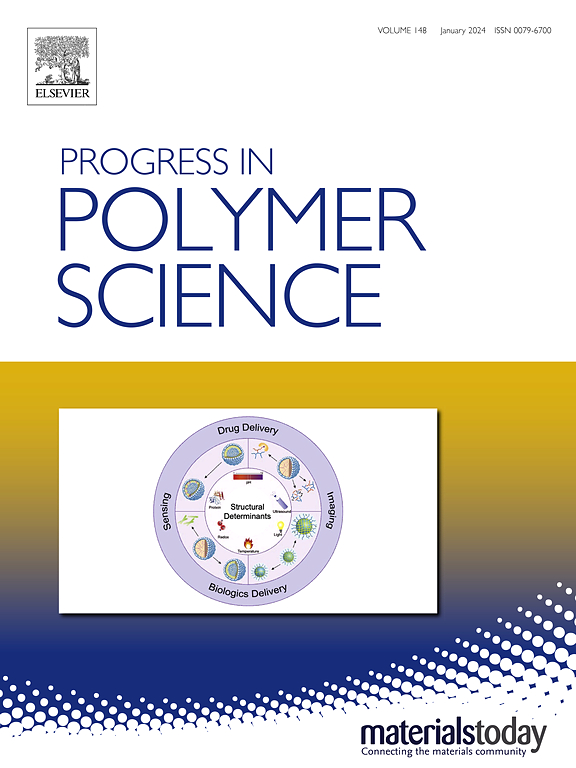Polymeric chemistry design for battery electrode binders
IF 26.1
1区 化学
Q1 POLYMER SCIENCE
引用次数: 0
Abstract
Polymer binders are essential for battery electrode stability, ensuring adhesion and cohesion, facilitating active material dispersion, and providing mechanical resilience against cycling-induced stresses. However, conventional binders such as poly(vinylidene fluoride) and carboxymethyl cellulose/styrene-butadiene rubber, which are widely used in lithium-ion battery electrodes, struggle to meet these functional requirements, particularly in high-capacity and high-voltage electrodes. These limitations affect electrochemical performance, cycle life, and manufacturability, necessitating a new paradigm in battery design. Recent advances in polymer chemistry and molecular engineering have enabled the development of functional binders that offer improved mechanical properties, interfacial stability, and electrochemical compatibility. This review comprehensively examines binder design approaches, emphasizing quantitative structure–property relationships to provide a predictive framework for rational binder engineering. Key focus areas include adhesion and cohesion, dispersion stability, mechanical strength, and electrochemical stability, alongside emerging functionalities such as ionic/electrical conductivity, electrolyte compatibility, and flame retardance. By integrating multi-scale engineering approaches with case studies on silicon anodes, nickel-rich cathodes, dry-processed electrodes, and emerging electrodes, this review presents a strategic roadmap for the innovation of next-generation binder. The insights presented herein offer a scientifically grounded, application-driven framework for the development of scalable, high-performance, and sustainable binder technologies that will shape the future of advanced battery materials.


电池电极粘合剂的聚合化学设计
聚合物粘合剂对于电池电极的稳定性至关重要,它可以确保电池的附着力和凝聚力,促进活性材料的分散,并提供抗循环应力的机械弹性。然而,广泛用于锂离子电池电极的传统粘合剂,如聚偏氟乙烯和羧甲基纤维素/丁苯橡胶,难以满足这些功能要求,特别是在高容量和高压电极中。这些限制影响了电化学性能、循环寿命和可制造性,需要一种新的电池设计范式。聚合物化学和分子工程的最新进展使功能粘合剂的发展能够提供更好的机械性能、界面稳定性和电化学相容性。这篇综述全面考察了粘合剂设计方法,强调定量的结构-性能关系,为合理的粘合剂工程提供预测框架。重点关注的领域包括附着力和内聚性、分散稳定性、机械强度和电化学稳定性,以及离子/电导率、电解质相容性和阻燃性等新兴功能。通过将多尺度工程方法与硅阳极、富镍阴极、干加工电极和新兴电极的案例研究相结合,本文提出了下一代粘合剂创新的战略路线图。本文提出的见解为可扩展、高性能和可持续的粘合剂技术的发展提供了一个科学的、应用驱动的框架,这将塑造先进电池材料的未来。
本文章由计算机程序翻译,如有差异,请以英文原文为准。
求助全文
约1分钟内获得全文
求助全文
来源期刊

Progress in Polymer Science
化学-高分子科学
CiteScore
48.70
自引率
1.10%
发文量
54
审稿时长
38 days
期刊介绍:
Progress in Polymer Science is a journal that publishes state-of-the-art overview articles in the field of polymer science and engineering. These articles are written by internationally recognized authorities in the discipline, making it a valuable resource for staying up-to-date with the latest developments in this rapidly growing field.
The journal serves as a link between original articles, innovations published in patents, and the most current knowledge of technology. It covers a wide range of topics within the traditional fields of polymer science, including chemistry, physics, and engineering involving polymers. Additionally, it explores interdisciplinary developing fields such as functional and specialty polymers, biomaterials, polymers in drug delivery, polymers in electronic applications, composites, conducting polymers, liquid crystalline materials, and the interphases between polymers and ceramics. The journal also highlights new fabrication techniques that are making significant contributions to the field.
The subject areas covered by Progress in Polymer Science include biomaterials, materials chemistry, organic chemistry, polymers and plastics, surfaces, coatings and films, and nanotechnology. The journal is indexed and abstracted in various databases, including Materials Science Citation Index, Chemical Abstracts, Engineering Index, Current Contents, FIZ Karlsruhe, Scopus, and INSPEC.
 求助内容:
求助内容: 应助结果提醒方式:
应助结果提醒方式:


